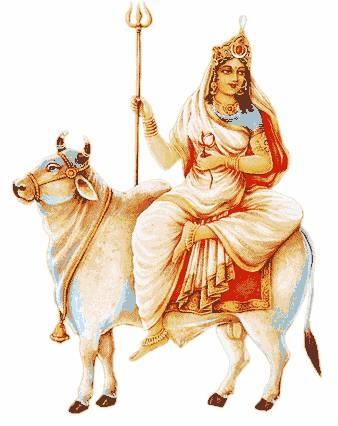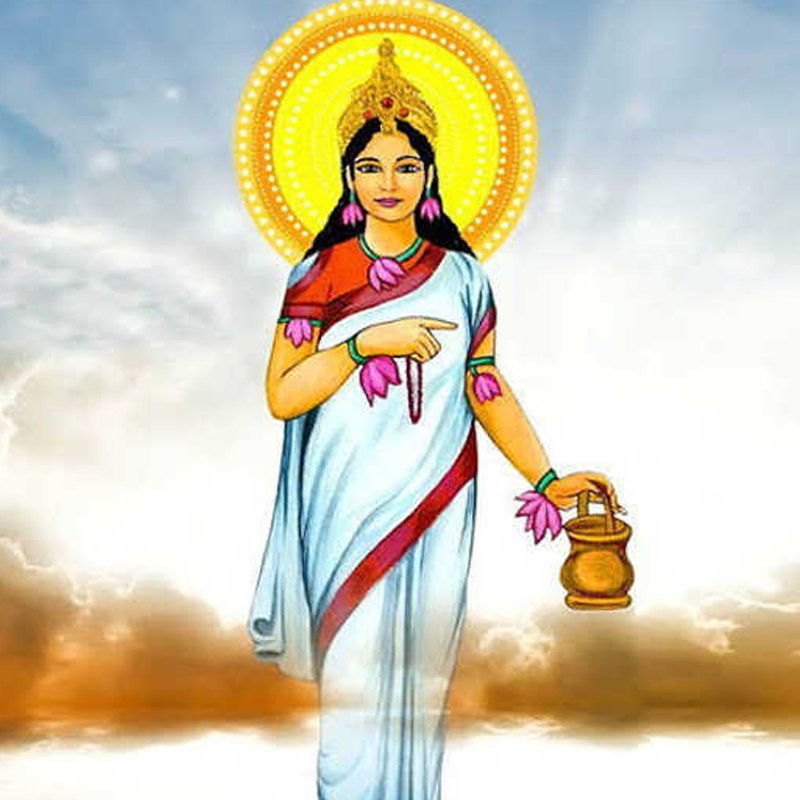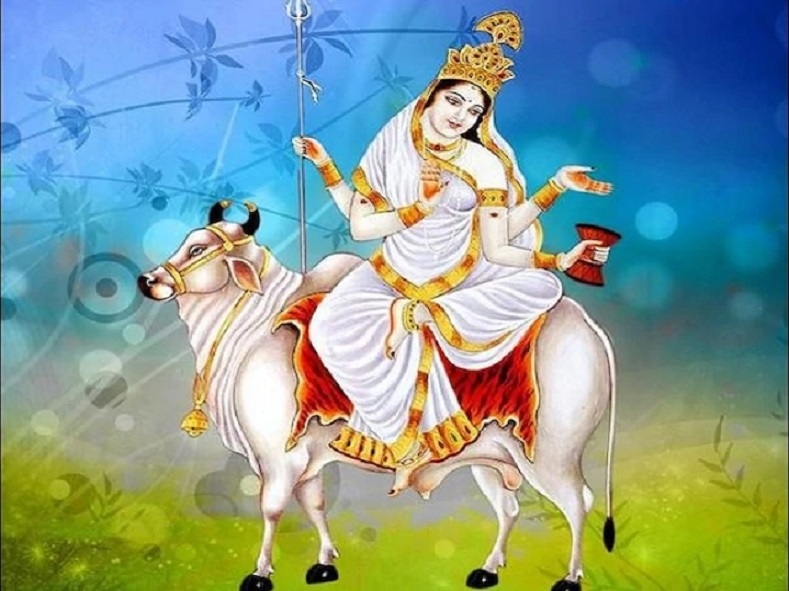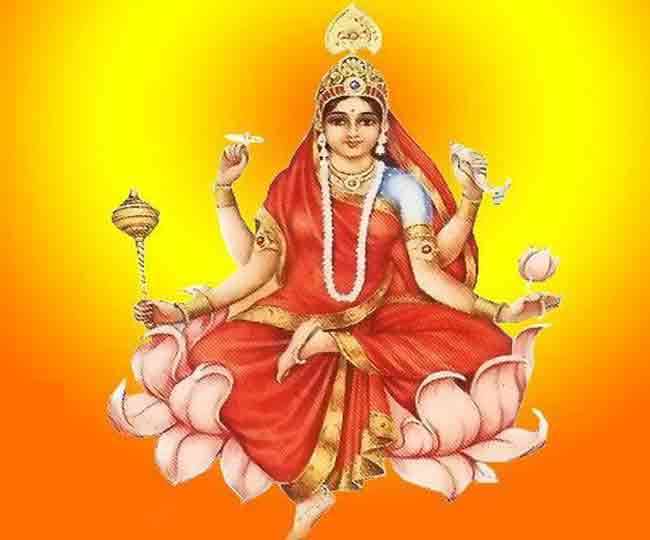Sharad Navratri or Durga Puja celebrates the death of the demon Mahishasura at the hands of Goddess Durga after nine days of pitch battle. During the Navratras the Hindu festival revering the feminine power, devotees pray to Navdurga, the nine different avatars or incarnations of Shakti. This year the Sharad Navratri, the festival symbolizing the victory of good over evil will be observed from 7th October to 15th October. (the Navratri Tritiya and Chaturthi Tithis are on the same day). To enhance the festivities devotees associate each day with unique colours.
SHAILPUTRI
 The nine-day long festival, Navratri commences on Pratipada of the Shukla Paksha of the Ashwin month with Kalasha Sthapana or Ghatasthapana and the celebration of the avatar of Shailputri.
The nine-day long festival, Navratri commences on Pratipada of the Shukla Paksha of the Ashwin month with Kalasha Sthapana or Ghatasthapana and the celebration of the avatar of Shailputri.
Shailputri, the daughter of Himavat, the king of the Himalayas is the most important of all the nine forms of Durga, because she is the embodiment of the powers of Brahma, Vishnu and Shiva and a manifestation of Mother Nature.
Shailputri, like Goddess Sati, her previous incarnation, is paid obeisance as the consort of Lord Shiva.
Sati was the daughter of Daksha Prajapati, one of the sons of Brahma and a great king. Sati married Shiva, much against her father’s wishes, and made mount Kailasa her abode.
Soon Daksha performed a Mahayagna, invited all the Gods except Shiva and Sati. Sati in spite of Shiva’s dissuading reached the Yagnasala to take part in the rituals along with her family. At the gathering, Daksha was hostile to her and insulted Shiva openly. Unable to bear the barbs and indignities by her own family, Sati immolated herself in the sacrificial fire.
When an enraged Shiva heard what had transpired, he came charging to kill Daksha and destroy the Yagnasala. Vishnu pacified him with invocations. A grieving Shiva carried back the burnt remains of Sati. The places where parts of Sati’s body fell are famous as Shakti Peethas.
Sati was reborn as Shailputri and eventually married Shiva.
They say, Shailaputri resides in Muladhara Chakra, the source of innate Shakti. Believers begin their spiritual journey by focussing on this chakra hoping to be bestowed with strength, courage, and composure.
According to Drik Panchang, Goddess Shailputri, or Parvati governs the moon who is the provider of all fortunes. She has a crescent moon on her forehead, carries a lotus in one hand, a trident in the other and uses a bull (Nandi) as her vehicle.
This year, Yellow, the colour for Pratipada symbolises joy and cheerfulness
BRAHMACHARINI
 The avatar of Brahmacharini is celebrated on Dwitiya. Brahmacharini translates to an ardent follower(Charini) of Tapa or Penance.
The avatar of Brahmacharini is celebrated on Dwitiya. Brahmacharini translates to an ardent follower(Charini) of Tapa or Penance.
Parvati, like her previous incarnation Sati, expressed an intense desire to marry Shiva despite her parents discouraging her. Sage Narada advised Parvati to perform Tapasya or severe Penance to win over Shiva. Parvati did so for 5000 years by following extreme austerity under severest of conditions.
The gods meanwhile pleaded with Kamadeva, the God of love, to ignite desire in Shiva’s heart for Parvati. This was imperative because the terrible demon Tarakasura could be killed only by Shiva’s child and Shiva was still grieving over Sati’s demise.
Sadly, Kamadeva, as he shot Shiva with his arrow of passion, was burnt to smithereens when an annoyed Shiva opened his third eye.
Parvati didn’t lose hope, and like Shiva followed asceticism. Her devout passion and ardent pursuit finally caught the attention of Shiva. Shiva visited Parvati in a disguise and tried to change her mind by listing out his weaknesses, and traits. A determined Parvati didn’t veer from her chosen path.
Her Tapasya eventually won over Shiva. Together they became the much revered ArtdhaNareeshwara
Brahmacharini holds a Kamandalam in her left hand and a rosary in her right hand. The Avatar of Brahmacharini teaches us the power of penance, devotion and solitude. Devotees pray to Brahmacharini hoping for strength and fortitude
This year, Green the colour of Dwitiya symbolises Mother Nature and her nourishing qualities
CHANDRAGHANTA
 Tritiya worships the avatar of Chandraghanta, the third incarnation of Durga.
Tritiya worships the avatar of Chandraghanta, the third incarnation of Durga.
Sati, the previous incarnation of Parvati, had married Shiva against her father Daksha’s wishes. Sati then immolated herself as she was disgraced publicly. An aching Shiva stayed away from the universe. Sati was reborn as Parvati to King Himavat. Parvati wanted to marry Shiva and as told by Sage Narada did severe Tapasya to win over Shiva’s aching heart.
Shiva finally relented for the marriage and came to his wedding arena clad in tiger skin, long matted hair, snakes around his neck, and sacred ash smeared all over. He was accompanied by ghouls, ghosts, and sadhus. Seeing his frightening form most of the guests fainted. To avoid further unhappiness, Parvati then assumed a powerful Shakti avatar namely ChandraGhanta. Uttering with many prayers, she requested Shiva to assume a more personable form.
Their marriage took place once Shiva and Parvati transformed into beautiful creatures.
Chandraghanta, with the lion as her vehicle, carries a Kamanadal, a mace, a bell (Ghanta), a trident, a lotus and more in her ten arms. She is compassionate to her devotees and terrifying to their enemies.
KUSHMANDA
 On Chaturthi the devotees pray to Kushmanda. Kushmanda avatar is believed to be the source of all light and energy.
On Chaturthi the devotees pray to Kushmanda. Kushmanda avatar is believed to be the source of all light and energy.
When the world was enveloped in darkness, Kushmanda with her radiantly dazzling smile produced a small cosmic egg (Ku + Ushma (energy) + Anda).
After creating the universe, Kushmanda with her left eye created the terrifying Mahakali, from the right eye the benevolent Mahasaraswati and from the central eye the powerful Mahalakshmi.
Mahakali gave birth to Shiva and Saraswati. Mahalakshmi gave form to Brahma and Lakshmi. Mahasaraswati created Vishnu and Shakti.
With Kushmanda’s blessings, Vishnu and Lakshmi, Shiva and Shakti, Brahma and Saraswati became the first celestial couples.
Kushmanda assimilated the powers of the three supreme female forms and became the unending source of incredible energy.
Kushmanda bestows prosperity and powers and removes hurdles
This year, Grey the colour of the day signifies the destruction of evil.
SKANDAMATA
 Panchami worships the avatar of Skandamata.
Panchami worships the avatar of Skandamata.
The Panchama Roop of Shakti is Skandamata, the mother(Mata) of Skanda( Kartikeya) the firstborn of Shiva and Parvati whose celestial destiny was to be the destroyer of Tarakasura.
Sati, the previous incarnation of Parvati, had chosen Shiva. Her bitter father Daksha disowned her. Sati then immolated herself as she was disgraced publicly by Daksha. A grieving Shiva withdrew himself from worldly affairs causing utter chaos.
Sati reborn as Parvati, after intense penance married Shiva. Their celestial union and combined energy produced a fiery seed. Lord Agni was entrusted to carry it to the river Ganga who safeguarded in Saravana lake till Parvati assumed the form of a water body, bore the seed and gave birth to Kartikeya. Once old enough, Kartikeya or Skanda killed Tarakusura.
Parvati or Skandamata as the mother of supremely gifted children namely Skanda and Vinayaka, is worshipped for salvation. She adorns a lotus, rides a lion and holds Skanda.
This year, Orange the colour of Panchami symbolises tranquillity, brightness and knowledge
KATYAYANI
 Shashti pays obeisance to the avatar of Katyayani, the sixth Avatar of Durga. Katyayani or Mahishasura Mardhini is the embodiment of all the powerful energies of the holy trinity of Brahma, Vishnu, Maheshwara and the celestial Gods led by Indra.
Shashti pays obeisance to the avatar of Katyayani, the sixth Avatar of Durga. Katyayani or Mahishasura Mardhini is the embodiment of all the powerful energies of the holy trinity of Brahma, Vishnu, Maheshwara and the celestial Gods led by Indra.
This form of Shakti was created to end the havoc of the asuras. She was named Katyayani because she was born to Rishi Katya who prayed fervently for an offspring.
Katyayani was raised as a fighter with the purpose to be a vanquisher. To aid her, the Gods gave her their famed powerful weapons to defeat Mahishasura, the demon king who could transform into a water buffalo at will. Katyayani, in her fiercest form, cut off the buffalo head of the Mahishasura bringing peace and tranquillity to all.
Katyayani’s victory over evil is celebrated across India as Durga Puja.
This year, White the colour of Shashti represents peace, serenity, calm and purity
KAALARATRI
 Saptami celebrates the incarnation of Kaalaratri.
Saptami celebrates the incarnation of Kaalaratri.
Ratri translates to night or darkness and Kaal is time or death. This avatar of Parvati is the slayer of ignorance.
When the two demons Shumbha and Nishumbha invaded Devaloka and dethroned Indra and drove him away from Swarga, the celestial god sought help from Shiva and Parvati. Parvati gave form to a fearsome goddess Chandi to tame the asura generals of Shumbha namely Chanda and Munda. Chandi created a menacing Kaalaratri with skin as dark as the Amavasya (new moon night) and bountiful untamed hair. Kaalaratri with her three eyes and nostrils emitting fire vanquished the two demon generals with her scimitar and thunderbolt. Chandi crushed Shumbha and Nishumbha.
Soon Raktabeeja, a demon with a peculiar boon surfaced to kill Kaali. Whenever this demon shed blood, each drop gave birth to a clone. A ferocious and raging Kaalaratri, drank his oozing blood as she attacked him and eventually killed Raktabeeja.
Kaalaratri, the destroyer of darkness, is worshipped as the bestower of light.
This year, Red the colour of Saptami signifies passion, auspiciousness as well as anger required to uproot evil.
MAHA GAURI
 Ashtami celebrates the form of Maha Gauri.
Ashtami celebrates the form of Maha Gauri.
Parvati, like her previous incarnation Sati, wanted to be the consort of Shiva. Sage Narada advised her to practice extreme asceticism and lead an austere life under the harshest of jungles and weather. As thousands of years passed by, Parvati’s lustrous skin got covered with dirt, insects, dead leaves. Pleased by her devotion, Shiva agreed to marry Parvati, bathed her with the waters of the Ganga flowing from his matted hair. Parvati, clad in white, and as fair as the jasmines, emerged as new.
Parvati as KaalaRatri vanquished many evildoers. As her radiant skin got dull with incessant combats, Parvati rejuvenated herself and became Maha Gauri.
Maha Gauri is symbolic of loyalty in relationships
This year, Royal Blue the colour of Ashtami exemplifies divine energy.
SIDDHIDHATRI
 Navami celebrates the avatar of Siddhidhatri.
Navami celebrates the avatar of Siddhidhatri.
Siddhi is the meditative ability and Dhatri is the bestower.
When there was no universe and only a black void was prevalent, Kushmanda created the cosmos with her divine smile. She created the Holy Trinity of Brahma, Vishnu and Shiva. Kushmanda also created Siddhidhatri, the goddess who bestowed upon Shiva the 18 siddhis or perfections. Goddess Siddhidhatri entrusted Brahma to take up the role as the creator of worlds, Vishnu with the role of preserving the creation and its creatures, and Mahadev with the role of destroying the worlds when it is time. Brahma, the creator, found his task very daunting because he needed a man and a woman to further the universe. Siddhidhatri then took one half of Shiva’s body and Brahma proceeded to create the world.
Shiva was hailed as Ardhanareeshwara.
Siddhidhatri, possessor of the Astha Siddhis bestows spiritual wisdom.
The Navratri and Durga Puja festivities culminate on Dusserha/Vijaya Dashami with the Visarjan of the idols of Durga.
This year, Pink, the colour of Navami , symbolizes purity and compassion.
Purple, the colour of Dashami, represents ambition, goals, and energy
Anupama Jain is the author of 'When Padma Bani Paula', a breezy novel about acing the second chances of life by staying true to one’s roots, 'Masala Mix: Potpourri Of Shorts', a short story collection on the myriad manifestations of love. She is currently editing her third, ’Kings Saviours & Scoundrels -Timeless Tales from Katha Sarita Sagara’ A community builder, a multi-awarded blogger, and a mentor, Anupama is based out of Gurugram.


Comments